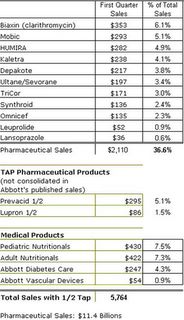The Good, The Bad, and The Ugly - US Bank
- The Good: Asset growth was 4.2%: retail loans were up 9.5% (nice growth), commercial loans were up 7.3% (I like it), and investment securities declined 4.3%. I am willing to ignore the decline in investment securities and focus on a big picture - loan growth.
- Fee revenues are up 4.9%. Credit card fees are up 8.5%, consumers are not giving up. European acquisition contributed about half of the growth in this segment (not as good as it appears).
- Non-interest expense is down 8.5% - great news. However, a big chunk of it was driven by a change in valuation of MSR (mortgage servicing rights). Also in the Q1 2005, USB took a charge for early debt repayment. Excluding the charge and MSR, expenses were about flat.
- Lower charge offs – loan charge off declined. Net charge offs inched 3bp higher, but it is still very close to an all-time low level of 0.55% of average loans. Overall credit quality is improving. This trend is very consistent across most banks. However, charge offs are likely to increase as interest rates rise.
- Acceleration of deposit growth, however, non-interest bearing deposits declined 2.1% where most growth came from time deposits greater than $100,000.
- Tier 1 ratio is at 8.6%, though 3 bp lower than it was last year but still a very solid number.
- Returned 108% of earnings to shareholders in the form of dividends and share buy backs. The dividend yield stands at an already high 4.3% and share buy backs added another 3.1%, resulting in a 7.4% return to shareholder yield.
- Efficiency ratio has declined to 41.7% - one of the lowest ratios I have ever seen – very good news.
- Part of it was attributed to the flattening of the yield curve. This got me thinking: further decline in the dollar and the Chinese possible de-linking their currency is likely to send U.S. interest rates higher, normalizing the yield curve. Another question, does the Fed really have control over interest rates?
- The rest was due to increased competition. Did USB originate that nice loan growth by undercutting competition?
The Ugly: There was nothing ugly in this quarter - I just like the title. But that is what is so great about USB - investors are unlikely to see anything ugly from this company. On another hand, half of “the good” bullets should be in the “the mediocre” column. I really like seeing asset growth, but I don’t put as much value on that growth when it comes at the expense of net interest margins. USB has one of the lowest cost structures in the industry, a big plus considering this is a commodity cut-throat business. Thus being a low cost producer allows the company to compete on price.
Very few positives in this quarter were organic. I am not accusing USB of using pesticides, but there is limit to the ‘non-organic.’ There were plenty of ‘one time’ items that helped to deliver the bottom line growth. The problem with one time items – they are non-recurring and they don’t provide great visibility into the future.
On a positive note, this quarter performance was a significant improvement from last quarter and last year’s. Deposits, loans and net interest income stopped declining and showed a sign of growth. I cannot really tell if the current performance is a fluke or if USB has been resuscitated. As ugly as the chart looks, USB doesn’t scare me. It seems that downside risk is minimal in this stock: it trades at 12 times 2005 earnings and is yielding 4.2%. It is very likely that interest margins will decline in the next quarter, as spreads are still very low. Contrary to common perception in the long-run interest rate spreads have little correlation with banks’ profitability (see chart below).
This less than spectacular performance placed USB on my probation list. If deposits, non-interest income and assets don’t start showing a more meaningful growth next quarter, I’ll have to part with USB. In the meantime, I welcome suggestions for a better bank with high a dividend, attractive valuation and great quality. Vitaliy N. Katsenelson, CFA Copyright Minyanville.com 2005











